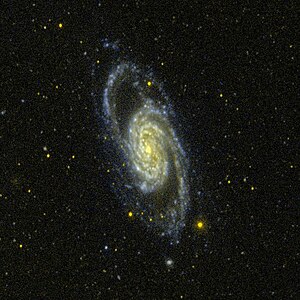NGC 2903
| NGC 2903 | |
|---|---|
 An ultraviolet image of NGC 2903 taken with GALEX. | |
| Observation data (J2000 epoch) | |
| Constellation | Leo |
| Right ascension | 09h 32m 10.111s[1] |
| Declination | +21° 30′ 02.99″[1] |
| Redshift | 556±1 km/s[2] |
| Distance | 30.4 Mly (9.33 Mpc)[3] |
| Group or cluster | Virgo Supercluster[4] |
| Apparent magnitude (V) | 9.0[5] |
| Characteristics | |
| Type | SBbc[6] or SAB(rs)bc[7] |
| Size | 100,000 ly (diameter) |
| Apparent size (V) | 11′.48 × 5′.25[8] |
| Other designations | |
| UGC 5079, IRAS 09293+2143,[9] PGC 27077[2] | |
NGC 2903 is an isolated barred spiral galaxy in the equatorial constellation of Leo, positioned about 1.5° due south of Lambda Leonis.[10] It was discovered by German-born astronomer William Herschel, who cataloged it on November 16, 1784. He mistook it as a double nebula, as did subsequent observers, and it wasn't until the nineteenth century that the Third Earl of Rosse resolved into a spiral form.[5] J. L. E. Dreyer assigned it the identifiers 2903 and 2905 in his New General Catalogue; NGC 2905 now designates a luminous knot in the northeastern spiral arm.[11]
This field galaxy[12] is located about 30[3] million light-years away from the Milky Way, and is a member of the Virgo Supercluster.[4] The morphological classification of this galaxy is SBbc,[6] indicating a barred spiral (SB) with moderate to tightly-wound spiral arms (bc). De Vaucouleurs and associates assigned it the class SAB(rs)bc, suggesting a weaker bar structure (SAB) with a partial ring (rs). The bar structure appears stronger in the near infrared band. The galaxy as a whole is inclined by an angle of 60° to the line of sight from the Earth.[7]
72% of the stellar mass is located in the outer disk of the galaxy, and 20% is found in the bar. The bulge adds 5% of the stellar mass, and its star population is generally older.[13] However, the central ~650 pc radius volume of the core is a strong starburst region. The star formation rate here is 0.7 M☉ y−1 and it is being fed by gas inflow along the bar. There is no evidence of an active nucleus.[7]
The irregular dwarf galaxy KKH 51 appears to be a companion, as they have an angular separation of 25′ and nearly the same radial velocity.[14]
References
- ^ a b Skrutskie, Michael F.; Cutri, Roc M.; Stiening, Rae; Weinberg, Martin D.; Schneider, Stephen E.; Carpenter, John M.; Beichman, Charles A.; Capps, Richard W.; Chester, Thomas; Elias, Jonathan H.; Huchra, John P.; Liebert, James W.; Lonsdale, Carol J.; Monet, David G.; Price, Stephan; Seitzer, Patrick; Jarrett, Thomas H.; Kirkpatrick, J. Davy; Gizis, John E.; Howard, Elizabeth V.; Evans, Tracey E.; Fowler, John W.; Fullmer, Linda; Hurt, Robert L.; Light, Robert M.; Kopan, Eugene L.; Marsh, Kenneth A.; McCallon, Howard L.; Tam, Robert; Van Dyk, Schuyler D.; Wheelock, Sherry L. (1 February 2006). "The Two Micron All Sky Survey (2MASS)". The Astronomical Journal. 131: 1163–1183. doi:10.1086/498708. ISSN 0004-6256.
- ^ a b "NASA/IPAC Extragalactic Database". Results for NGC 2903. Retrieved 2006-11-25.
- ^ a b Tully, R. Brent; et al. (August 2016). "Cosmicflows-3". The Astronomical Journal. 152 (2): 21. arXiv:1605.01765. Bibcode:2016AJ....152...50T. doi:10.3847/0004-6256/152/2/50. 50.
- ^ a b "Nearby Groups of Galaxies". ned.ipac.caltech.edu. Retrieved 2018-05-03.
- ^ a b O'Meara, Stephen James (2007). Hidden treasures. Cambridge University Press. p. 256. ISBN 9780521837040.
- ^ a b Ann, H. B.; et al. (2015). "A Catalog of Visually Classified Galaxies in the Local (z ∼ 0.01) Universe". The Astrophysical Journal Supplement Series. 217 (2): 27–49. arXiv:1502.03545. Bibcode:2015ApJS..217...27A. doi:10.1088/0067-0049/217/2/27.
- ^ a b c Yukita, Mihoko; et al. (October 2012). "Hot Diffuse Emission in the Nuclear Starburst Region of NGC 2903". The Astrophysical Journal. 758 (2): 17. arXiv:1209.5443. Bibcode:2012ApJ...758..105Y. doi:10.1088/0004-637X/758/2/105. 105.
- ^ Paturel, G.; et al. (December 2003). "HYPERLEDA. I. Identification and designation of galaxies". Astronomy and Astrophysics. 412: 45–55. Bibcode:2003A&A...412...45P. doi:10.1051/0004-6361:20031411.
- ^ "NGC 2903". SIMBAD. Centre de données astronomiques de Strasbourg. Retrieved 2020-09-14.
- ^ Sinnott, Roger W.; Perryman, Michael A. C. (1997). Millennium Star Atlas. Vol. 2. Sky Publishing Corporation and the European Space Agency. p. 686. ISBN 0-933346-83-2.
- ^ Moore, S. L.; et al. (April 2010). "NGC 2903 - the galaxy Messier missed". Journal of the British Astronomical Association. 120 (2): 106–107. Bibcode:2010JBAA..120..106M.
- ^ Materne, J. (April 1979). "The structure of nearby groups of galaxies - Quantitative membership probabilities". Astronomy and Astrophysics. 74 (2): 235–243. Bibcode:1979A&A....74..235M.
- ^ Carrillo, Andreia; et al. (April 2020). "The VIRUS-P Exploration of Nearby Galaxies (VENGA): the stellar populations and assembly of NGC 2903's bulge, bar, and outer disc". Monthly Notices of the Royal Astronomical Society. 493 (3): 4094–4106. arXiv:2002.02858. Bibcode:2020MNRAS.493.4094C. doi:10.1093/mnras/staa397.
- ^ Makarova, L. N.; et al. (March 2002). "Surface photometry of new nearby dwarf galaxies". Astronomy and Astrophysics. 384: 72–80. arXiv:astro-ph/0201234. Bibcode:2002A&A...384...72M. doi:10.1051/0004-6361:20020006.
External links
- SEDS: Spiral Galaxy NGC 2903
- NOAO: NGC 2903
- NASA Astronomy Picture of the Day: Barred Spiral Galaxy NGC 2903 (21 March 2001)
- NASA Astronomy Picture of the Day: Bright Galaxy NGC 2903 (6 July 2007)
- NGC 2903 on WikiSky: DSS2, SDSS, GALEX, IRAS, Hydrogen α, X-Ray, Astrophoto, Sky Map, Articles and images